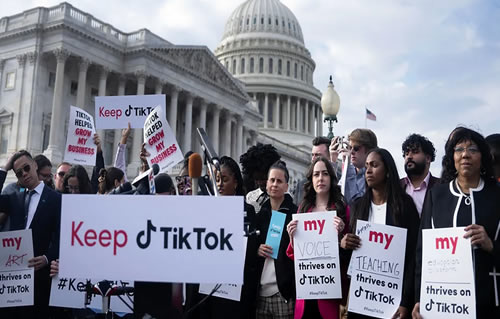TikTok was one of India's most popular apps – until it was banned in 2020. It's a lesson for what might unfold if a US ban goes ahead. Four years ago, India was TikTok's biggest market. The app boasted a growing base of 200 million users, thriving subcultures and sometimes life-changing opportunities for creators and influencers. TikTok seemed unstoppable – until simmering tensions on the border between India and China erupted into deadly violence. After the border skirmish, the Indian government banned the app on 29 June 2020. Almost overnight, TikTok was gone. But the accounts and videos of Indian TikTok are still online, frozen in time when the app had just emerged as a cultural giant. In some ways, it could offer a preview of what might lie on the horizon in the United States. In April, 2024 President Joe Biden signed a bill into law that could ultimately ban TikTok from the US, marking a new chapter after years of threats and failed legislation. The law requires the company that owns TikTok, ByteDance, to sell its stake in the app within the next nine months, with a further three-month grace period, or face a potential ban in the country. ByteDance says it has no intention of selling the social media platform, but on 6 December, a US federal appeals court rejected the company's bid to overturn the law. The platform is set to become unavailable on 29 January, though some observers expect the case will make it to the Supreme Court, the highest authority in the US.
Banning a massive social media app would be an unprecedented moment in American tech history, though the looming court battle currently leaves TikTok's fate uncertain. But the Indian experience shows what can happen when a major country wipes TikTok from its citizen's smartphones. India is not the only country to have taken the step either – in November 2023, Nepal also announced a decision to ban TikTok and Pakistan has implemented a number of temporary bans since 2020. As the app's 150 million US users swipe through videos in limbo, the story of India’s TikTok ban shows that users are quick to adapt, but also that when TikTok dies, much of its culture dies with it.
Sucharita Tyagi, a film critic based in Mumbai, had grown her account to 11,000 followers when TikTok came down, with some of her videos racking up millions of views.
"TikTok was huge. People were coming together all over the country, dancing, putting up skits, posting about how they run their homestead in their small town in the hills," says Tyagi. "There was a massive number of people who suddenly had this exposure that they had always been denied, but now it was possible."
The app was a particular phenomenon because of the ways its algorithm gave opportunities to rural Indian users, who were able to find an audience and even reach celebrity status not possible on other apps.
"It democratised content creation for the first time," says New Delhi-based technology writer and analyst Prasanto K Roy. "We began to see a lot of these very rural people fairly low down on the socio-economic ladder who would never dream of getting a following, or making money on it. And TikTok's discovery algorithm would deliver it to users who wanted to see it. There was nothing quite like it in terms of hyper-local videos."
When TikTok went offline in India, the government banned 58 other Chinese apps along with it
TikTok holds a similar cultural significance in the US, where niche communities flourish and an untold number of small creators and businesses base their livelihood around the app. It's a kind of success that's less prevalent on other social media platforms. Instagram, for example, is generally tuned more for consuming content from accounts with big followings, while TikTok places a heavier emphasis on encouraging regular users to post.
When TikTok went offline in India, the government banned 58 other Chinese apps along with it, including some that are currently growing in popularity in the US today, such as the fashion shopping app Shein. As the years rolled on, India banned over a hundred more Chinese apps, though negotiations recently brought an Indian version of Shein back online.
The same could happen in the US. The new law sets a precedent and creates a mechanism for the American government to get rid of other Chinese apps. The privacy and national security concerns politicians voice about TikTok could apply to a host of other companies as well.
And when a popular app is removed, others can attempt to fill the gap. "As soon as TikTok was banned it opened up a multibillion-dollar opportunity," says Nikhil Pahwa, an Indian tech policy analyst and founder of the news site MediaNama. "Multiple Indian start-ups launched or pivoted to fill the gap."
Getty Images The prospect of a TikTok ban in the US has concerned many small businesses and professionals who rely on the platform (Credit: Getty Images)
Source : https://www.bbc.com/future/article/20240426-the-ghosts-of-indias-tiktok-social-media-ban





